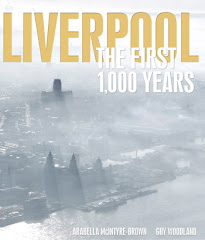
Who were the original Scousers? The Neolithic Boat People can probably claim the title in Liverpool’s prehistory; on marsh and heathland they created scattered settlements of fishers and farmers. The Romans weren’t impressed, although they did build a road through here, they stuck to Chester and other less boggy parts of the North West. (Chester’s Roman name was Deva; our name for it derives from the Latin word castra, or camp: hence Man-, Rib-, Win-, Chi-, Dor-chester, etc.)
Saxons drifted in, building small settlements and churches; Vikings, who had been raiding the west coast sporadically for a while, eventually started to settle and built more churches. Place names and a few archaeological finds are all that’s left of these early settlements.
The Normans, auditing their newly acquired kingdom in 1086, didn’t bother to note down Liverpool in the Domesday Book. Toxteth, yes, and West Derby, but not Liverpool. It wasn’t till King John (bad King John, Richard the Lionheart’s naughty younger brother) twigged that Liverpool was a handy point of departure for Ireland that things started to move. For the next 300 years the population grew as soldiers were shipped in and out along the Mersey, traders started to scent a new market and moved in, and the town began to establish itself. Under the reigns of the Tudors and Stuarts, Liverpool stagnated; the Civil War and a string of plagues knocked the town for six.
From the late 1600s, though, Liverpool opened up to the world, and the world obliged by turning up to see what was going on. But while strangers from distant parts might have brought a little spice to the town, much of Liverpool’s modern culture was imported from nearer neighbours – Wales, Scotland and Ireland.
The Welsh came to Liverpool in droves; the first Welsh chapel was built in Pall Mall in 1787; the Welsh population grew so large that Pall Mall became known as Little Wales, and in 1788 there was even a Liverpool Welsh penny minted. They may have been here a good deal earlier; place names like Walton and Wallasey (on the Wirral) suggest that Welsh Celts may have made their homes here in the first millennium AD. By 1813 one in ten of Liverpool’s citizenry were Welsh and over the next 40 years the Welsh community grew from 8,000 to 40,000, many of whom spoke no English; in Everton and Kirkdale advertising hoardings and local newspapers were in Welsh. At the end of the 19th century, there were four National Eisteddfodau held in Liverpool – in 1840, 1855, 1884 and 1900.
As for the Scots, they came to prosper. Medics, scholars, engineers and entrepreneurs saw opportunity in Liverpool – famous names such as Gladstone and Laird, for example. By 1837 there were enough Scots to support six congregations (the Scottish church of St Andrews, though ruined, is still in Rodney Street) and they prospered in ship-building, rope-making, engineering, and sugar-refining. The Scottish presence was less obvious than the Welsh or Irish because the community didn’t live in definable areas; the independent Scots weaved themselves into the fabric of Liverpool life in more subtle patterns...............

No comments:
Post a Comment